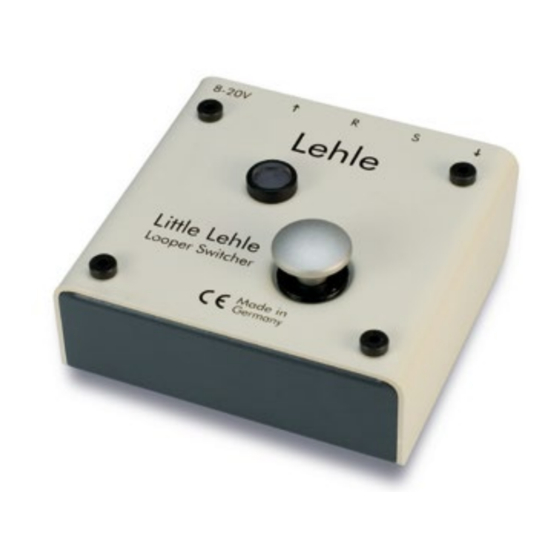Summary of Contents for Lehle Little Lehle II
-
Page 1: Operating Instructions
Little Lehle II Operating instructions Lehle GmbH • Grenzstr. 153 • D-46562 Voerde • Germany • Tel +49 (0) 2855 850070... - Page 2 1999. Your new Little Lehle II comprises only the very best compo- nents. Every assembly of your Little Lehle II has been made and tested in Germany. Your Little Lehle II is of extremely robust design and construction, to make sure that you get absolutely years and years of enjoyment from it.
-
Page 3: Table Of Contents
- Little Lehle II as an effects loop switcher ................8 - Little Lehle II as an effects loop switcher for Inserts between Send and Return of an amplifier .. 9 - Little Lehle II as an A/B switcher between two amplifiers ..........10 - Little Lehle II as an A/B switcher between two instruments .......... -
Page 4: Introduction
The Little Lehle II can also be used to switch be- tween two instruments on one amp or, vice versa, between two amps with one instrument. Extremely... -
Page 5: Technical Data
Technical data Weight: 360 g Length: 9 cm (3.5”) Width: 9.2 cm (3.6”) Overall height: 5 cm (2”) Voltage range: 8 - 20V DC or AC Max. power take-up: 20 mA Max. level: 36 dBU (40 mA) -
Page 6: General Description
General description... - Page 7 It has no function phones, for instance) and, of course, simple mono if the Little Lehle II is used as an A/B box for signals, like that of an electric guitar. operation with two amplifiers.
- Page 8 8. Base and fixing You can use the fixing screws supplied with the to it, to avoid interference noise during operation Little Lehle II to fix it to a base plate (or a pedal or when switching. board, for example).
- Page 9 Thanks to its ready-to-go fixing system, the Little Lehle II can be mounted without difficulty on a base plate. To do this, undo the four housing screws and detach the cover. Then fix the device base to a base plate using the two screws, the washers and the spacers supplied.
-
Page 10: Typical Uses
The Little Lehle II as an effects loop switcher Typical uses You can use the Little Lehle II as a loop switcher for individual effects units, and also for complete pedal boards. Not all effects pedals feature True Bypass, and those that don’t can cause signal loss- es when deactivated. -
Page 11: Little Lehle Ii As An Effects Loop Switcher For Inserts Between Send And Return Of An Amplifier
2. Connect the input of the effects unit with the Send (2) of the Little Lehle II. 3. Connect the output socket of the effects unit with the Return socket (3) of the Little Lehle II. 4. Connect the amplifier with the Output socket (4). -
Page 12: Little Lehle Ii As An A/B Switcher Between Two Amplifiers
2. Connect the input of the effects unit with the Send socket (2) of the Little Lehle II. 3. Connect the output socket of the effects unit with the Return socket (3) of the Little Lehle II. 4. Connect the Return of your amplifier with the Output socket (4). - Page 13 Send (2) Amp 1 guaranteed not to have ground loops when you Return (3) use the Little Lehle II, because it switches not Output (4) Amp 2 only the signal back and forth between the ampli- fiers, but also, simultaneously, the signal ground.
-
Page 14: Little Lehle Ii As An A/B Switcher Between Two Instruments
5. There you go! In order to swap between two instruments quickly and easily, you can install the Little Lehle II be- tween the instruments and the rest of your setup. It is not always possible to mute your amplifier or PA... -
Page 15: Little Lehle Ii As A Tuner-Mute Switcher
5. There you go! Even in smaller setups with only one guitar and one amplifier, the Little Lehle II can help by muting the signal while you are tuning up, so that your audience and your bandmates do not hear... -
Page 16: Little Lehle Ii As An Effects Loop Switcher For Microphones
More and more vocalists are using effects units to Balanced signal lines are fitted with XLR modify the sound of their voices. The Little Lehle II is optimally suitable for this function, too, since it can connectors or TRS (Tip Ring Sleeve) jack plugs. In a also switch balanced signals. -
Page 17: Troubleshooting
This is a mechanical noise caused by a flat spring which diverts the force of the True Bypass switch button on to the horizontal slide switch inside the Little Lehle II. So it is not a defect, not a Jack problem, just a healthy indication that the spring is... - Page 18 The Lehle DC Filter can be used behind the out- and/or other amplifier combinations. If, contrary put of the final effects unit to minimize switching...
- Page 19 What to do: 1. Connect the output of the effects unit to the DC socket of the Lehle DC Filter. 2. Connect the 0DC socket of the Lehle DC Filter to the return of the effects loop switcher. 3. There you go!
-
Page 20: Little Lehle Ii Signal Flow Diagram
Little Lehle II signal flow diagram...






Need help?
Do you have a question about the Little Lehle II and is the answer not in the manual?
Questions and answers